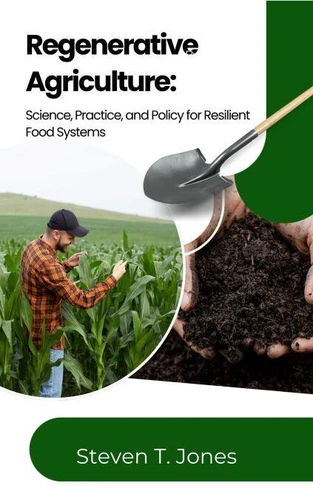Regenerative Agriculture: Science, Practice, and Policy for Resilient Food Systems
Par :Formats :
Disponible dans votre compte client Decitre ou Furet du Nord dès validation de votre commande. Le format ePub est :
- Compatible avec une lecture sur My Vivlio (smartphone, tablette, ordinateur)
- Compatible avec une lecture sur liseuses Vivlio
- Pour les liseuses autres que Vivlio, vous devez utiliser le logiciel Adobe Digital Edition. Non compatible avec la lecture sur les liseuses Kindle, Remarkable et Sony
 , qui est-ce ?
, qui est-ce ?Notre partenaire de plateforme de lecture numérique où vous retrouverez l'ensemble de vos ebooks gratuitement
Pour en savoir plus sur nos ebooks, consultez notre aide en ligne ici
- FormatePub
- ISBN8231745753
- EAN9798231745753
- Date de parution01/06/2025
- Protection num.pas de protection
- Infos supplémentairesepub
- ÉditeurWalzone Press
Résumé
Regenerative Agriculture: Science, Practice and Policy for Resilient Food Systems is the go-to guide for anyone who wants more than buzzwords and pretty farm photos. Written for agronomists, policy-makers, forward-looking farmers and graduate students, it braids cutting-edge science with concrete case studies to show-step by step-how agro-regeneration can restore soils, boost biodiversity, strengthen rural economies .
all while keeping the books in the black. Across twelve carefully structured chapters, the authors start with the global crisis of soil degradation and climate risk, then lay out the theoretical foundations of regenerative agriculture, its six key principles and the latest evidence from long-term trials and pioneering operations. You'll find in-depth explorations of no-till seeding, multi-species cover crops, holistic grazing and agroforestry, all backed by peer-reviewed data and forty years of field experimentation.
Farm economics are given equal weight: profit comparisons and farmer case studies show why regenerative systems are increasingly out-performing conventional ones in yield stability and net margins. But this book is no glossy manifesto. It tackles real obstacles-transition costs, knowledge gaps, policy lock-ins-and offers pragmatic roadmaps for scaling from pilot plots to national programs. Chapters devoted to innovation and public policy explain how AI-powered decision tools, supply-chain commitments and emerging soil-carbon markets can speed global adoption.
Finally, a forward-looking chapter sketches what a fully regenerative food system could look like by 2050, grounding optimism in rigorous analysis.
all while keeping the books in the black. Across twelve carefully structured chapters, the authors start with the global crisis of soil degradation and climate risk, then lay out the theoretical foundations of regenerative agriculture, its six key principles and the latest evidence from long-term trials and pioneering operations. You'll find in-depth explorations of no-till seeding, multi-species cover crops, holistic grazing and agroforestry, all backed by peer-reviewed data and forty years of field experimentation.
Farm economics are given equal weight: profit comparisons and farmer case studies show why regenerative systems are increasingly out-performing conventional ones in yield stability and net margins. But this book is no glossy manifesto. It tackles real obstacles-transition costs, knowledge gaps, policy lock-ins-and offers pragmatic roadmaps for scaling from pilot plots to national programs. Chapters devoted to innovation and public policy explain how AI-powered decision tools, supply-chain commitments and emerging soil-carbon markets can speed global adoption.
Finally, a forward-looking chapter sketches what a fully regenerative food system could look like by 2050, grounding optimism in rigorous analysis.
Regenerative Agriculture: Science, Practice and Policy for Resilient Food Systems is the go-to guide for anyone who wants more than buzzwords and pretty farm photos. Written for agronomists, policy-makers, forward-looking farmers and graduate students, it braids cutting-edge science with concrete case studies to show-step by step-how agro-regeneration can restore soils, boost biodiversity, strengthen rural economies .
all while keeping the books in the black. Across twelve carefully structured chapters, the authors start with the global crisis of soil degradation and climate risk, then lay out the theoretical foundations of regenerative agriculture, its six key principles and the latest evidence from long-term trials and pioneering operations. You'll find in-depth explorations of no-till seeding, multi-species cover crops, holistic grazing and agroforestry, all backed by peer-reviewed data and forty years of field experimentation.
Farm economics are given equal weight: profit comparisons and farmer case studies show why regenerative systems are increasingly out-performing conventional ones in yield stability and net margins. But this book is no glossy manifesto. It tackles real obstacles-transition costs, knowledge gaps, policy lock-ins-and offers pragmatic roadmaps for scaling from pilot plots to national programs. Chapters devoted to innovation and public policy explain how AI-powered decision tools, supply-chain commitments and emerging soil-carbon markets can speed global adoption.
Finally, a forward-looking chapter sketches what a fully regenerative food system could look like by 2050, grounding optimism in rigorous analysis.
all while keeping the books in the black. Across twelve carefully structured chapters, the authors start with the global crisis of soil degradation and climate risk, then lay out the theoretical foundations of regenerative agriculture, its six key principles and the latest evidence from long-term trials and pioneering operations. You'll find in-depth explorations of no-till seeding, multi-species cover crops, holistic grazing and agroforestry, all backed by peer-reviewed data and forty years of field experimentation.
Farm economics are given equal weight: profit comparisons and farmer case studies show why regenerative systems are increasingly out-performing conventional ones in yield stability and net margins. But this book is no glossy manifesto. It tackles real obstacles-transition costs, knowledge gaps, policy lock-ins-and offers pragmatic roadmaps for scaling from pilot plots to national programs. Chapters devoted to innovation and public policy explain how AI-powered decision tools, supply-chain commitments and emerging soil-carbon markets can speed global adoption.
Finally, a forward-looking chapter sketches what a fully regenerative food system could look like by 2050, grounding optimism in rigorous analysis.



